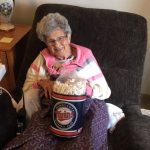Falls Prevention Awareness Week is September 21-25, 2020. The South Dakota Falls Prevention Coalition has developed a Falls Prevention Toolkit to increase awareness of the risks of falls and promote practical steps to reduce those risks.
The National Council of Aging also has a variety of resources including the interactive Falls Free Checkup, which provide a risk score and resources based on responses to 12 simple questions.
Early Morning Wake Up Call: Lynn B. Fjellanger’s Fall Story
Download the Word Version of Lynn Fjellanger’s Fall Story
On September 28, 2019, my life changed because of two “routine” falls. The cell phones started ringing at 1:01 AM: first my husband’s, then mine. As I answered, a first responder asked to talk to my husband regarding his father. “Your dad fell at home and your mother is not able to answer our questions.”
We immediately made eye contact, each with that ‘oh-brother-here-we-go-again’ look on our faces. Falls were happening with increasing frequency in the past six months as my father-in-law battled cancer and experienced weight loss, fatigue and balance issues. We had finally convinced my mother-in-law to stop trying to pick him up by herself and call 911. We knew the drill. My husband just said, “OK, we will meet you at the hospital. Tell my mom we are coming.”
As we pulled out of our driveway, we received another call from the first responder, “Is your dad a DNR?” Immediately we knew this was not the same old drill. When we arrived, my mother-in-law was being comforted by a chaplain. Definitely NOT the same old drill. The doctor came into the exam room. “Your husband has suffered a massive brain bleed and the pressure is pushing down on his brain stem.” I could feel my mother-in-law shaking under the arm I had around her shoulders. I knew this meant he would not be able to breath without a ventilator.
He lived for 12 more hours as family and friends gathered to say good-bye. We were all in shock. My mother-in-law kept saying, “But he hardly fell! He just went down onto his hands and knees and his head barely hit the side of the bed! He stood up and made it to the chair.”
His head hit a small metal support rod at just the right spot. With his platelets low due to cancer, his body was not able to stop the internal hemorrhaging. Those 12 hours were a blur of tears, hugs, handholding and prayers. Perhaps the most gut-wrenching moment was when my 23-year old son said a tearful goodbye over the phone while driving from college. As we held the speaker to his “Bompa’s” ear he sobbed, “I love you, Grandpa. You were my best friend. Please don’t go.”
 The cell phones rang again at 5:30 AM as we were holding vigil next to my father-in-law’s hospital bed. It was my sister, “Mom fell and I think it’s pretty bad this time.” My 94-year-old mother, who lives in my hometown’s nursing home 300 miles away, had fallen out of her chair trying to use the restroom. She was fully alert and oriented, but suffered a head injury and multiple fractures when she fell on the tile floor in her room.
The cell phones rang again at 5:30 AM as we were holding vigil next to my father-in-law’s hospital bed. It was my sister, “Mom fell and I think it’s pretty bad this time.” My 94-year-old mother, who lives in my hometown’s nursing home 300 miles away, had fallen out of her chair trying to use the restroom. She was fully alert and oriented, but suffered a head injury and multiple fractures when she fell on the tile floor in her room.
I helped make medical decisions on her behalf and the charge nurse wanted to know what they should do. My sister and I agreed they should make her comfortable ‘by whatever means are needed’ and let hospice take over. It was the most difficult phone call and decision of my life. We knew it would be excruciating and frightening for her to be jostled and moved for x-rays, scans and tests.
She lived for six more days surrounded by her five surviving children. We watched as her chest would rise and fall, rise and fall; holding our breath whenever she held hers. She comfortingly called out to her long-deceased mother and sister before passing. It was a privilege and blessing to witness this exchange.
During the next two weeks, I helped plan funerals, execute wills and move personal belongings and furniture. I also reflected back on what happened that warm and tragic Saturday in September. Both medical examiners had deemed my loved ones had died of complications due to a fall. I thought back on how falls had become such an accepted routine in both of their lives. This ‘here we go again’ and ‘how did she/he fall this time?’ attitude had made us complacent about preventing falls from happening in the first place.
Even with the medically complex and frail, I knew appropriately implemented prevention strategies are effective. There are so many options we could have endorsed, from adaptive equipment and exercise to positioning and room layout. Why wasn’t I more assertive and proactive? Why did I accept falls as a normal part of aging? Yes, underlying medical conditions contributed to their deaths, but the trauma and pain imposed by these falls may have been avoided.
I urge everyone to become aware, educated and involved with fall prevention activities and strategies on a personal, community and/or professional level. Hopefully, when your cell phones ring in the middle of the night, it is just a wrong number.
